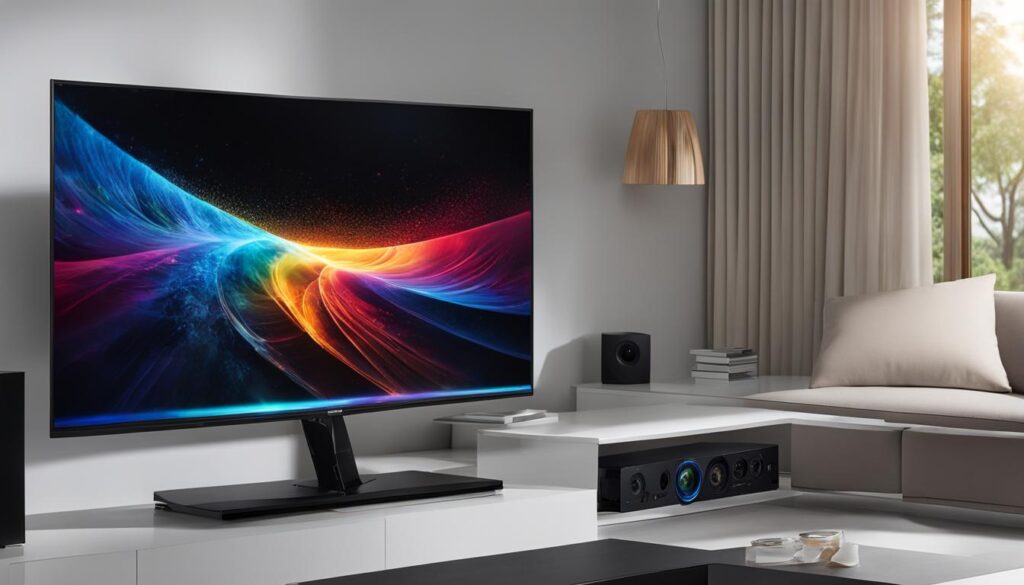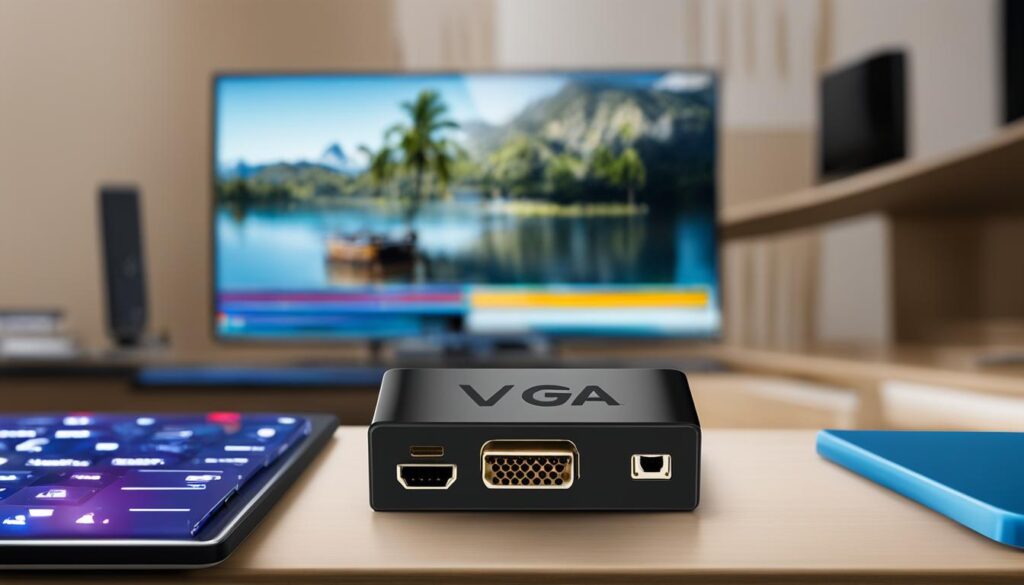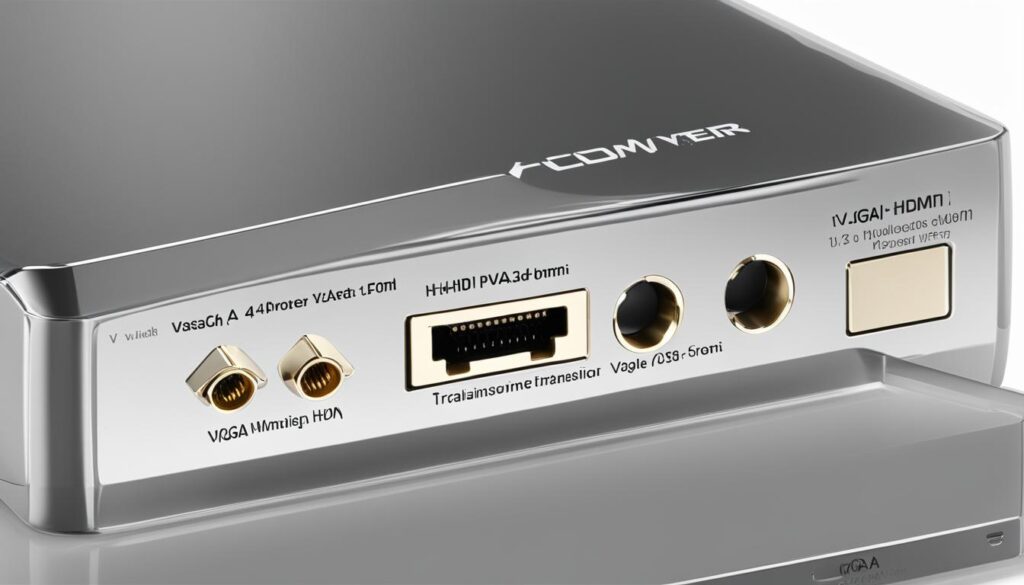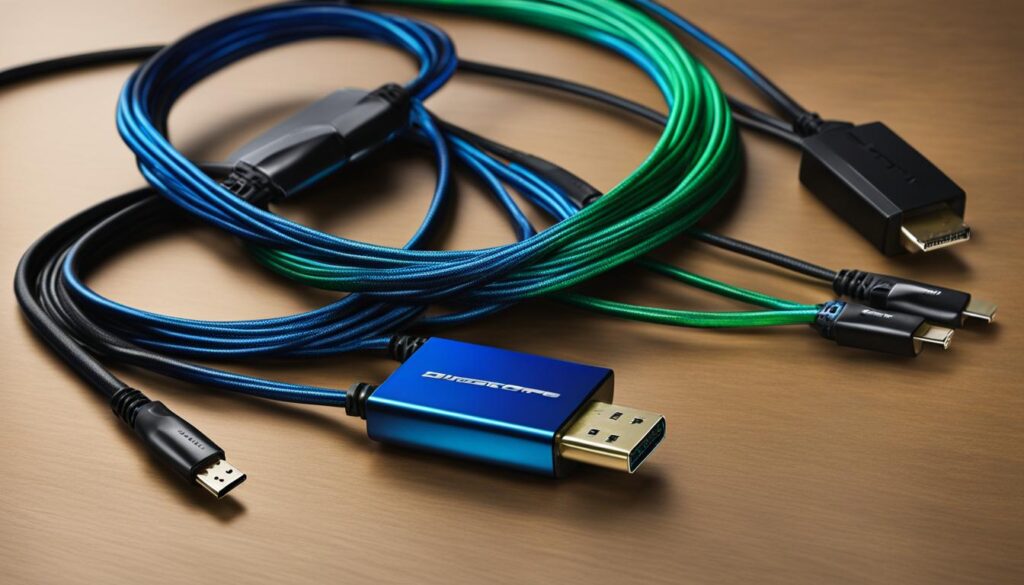Ever stare at that old, faithful laptop with its VGA port and wonder how you can bring it up to speed with your sleek, new HDMI-equipped TV? You’re not alone! In an age where high-definition rules the roost, finding a way to connect laptop to TV for a seamless video resolution may seem like a daunting task. But fear not, the solution is simpler than you might think. With the right HDMI adapter and a good-old VGA cable, analog to digital conversion is a breeze, making VGA to HDMI conversion the perfect bridge between old and new.
Your cherished memories housed on earlier tech can get a fresh lease on life through a VGA HDMI conversion. And while your device may not naturally speak the digital language of modern screens, a VGA converter can flawlessly translate every pixel and potentially every audio signal. So, whether it’s for work presentations or binge-watching sessions, learning how to convert VGA to HDMI can unlock a world where your legacy devices and cutting-edge equipment coexist harmoniously.
Key Takeaways
- Understanding the VGA to HDMI conversion process can extend the usefulness of your older tech devices.
- An HDMI cable paired with a VGA cable and adapter makes the digital connection possible.
- Advance from analog visuals to crystal-clear digital display with a reliable VGA converter.
- Audio signal transfer may require an additional step but ensures a fully synchronized multimedia experience.
- With a correct adapter, you can connect your laptop to your TV effortlessly.
- Assuring signal integrity is key when blending old analog and new digital interfaces.
Understanding VGA and HDMI Interfaces: A Brief Overview
Embarking on the journey of connecting your devices across different generations requires an understanding of the core video interfaces involved: the VGA standard and HDMI technology. Let’s start by exploring the analog signal transmitted through the VGA interface. VGA, which stands for Video Graphics Array, is synonymous with the 15-pin connector cable that many associate with older computers and projectors. This interface was designed for analog video only, and it notably lacks the capability to transmit audio.
Moving into the present, HDMI technology stands as the modern successor, offering digital connectivity for high-definition video and audio through a single interface. HDMI, or High-Definition Multimedia Interface, supports not only higher screen resolution but also an integrated audio signal, creating a more robust and streamlined connection between devices such as TVs, gaming consoles, and more. Here’s where we see a fundamental shift from VGA’s sole focus on video to HDMI’s comprehensive delivery of video and audio data.
To better understand the distinctions and capabilities of these two interfaces, let’s explore their characteristics:
| Feature | VGA | HDMI |
|---|---|---|
| Signal Type | Analog | Digital |
| Video Output | Supported | Supported |
| Audio Transmission | Not Supported | Supported |
| Maximum Resolution | Up to 2048×1536 (QXGA) | Up to 10K Resolution |
| Connector Pins | 15-Pin | 19-Pin |
| Audio/Video in One Cable | No | Yes |
While HDMI clearly delivers a more comprehensive and updated solution for display adapters, there are still many instances where you might need to utilize a VGA connection, especially when handling legacy equipment. Not to worry—you have options available to you.
If your device features a VGA output, but your screen only has an HDMI input, the bridge between the two is built by leveraging display adapters designed to convert the signals. As technology has progressed, these converters have become more accessible and user-friendly, ensuring your content doesn’t get left behind.
With the above overview, you’re now more acquainted with the foundational knowledge that will guide you in making informed decisions on how to best connect your VGA-only devices to the modern digital world. And as we continue, you’ll discover the intricacies of these connections and the practical solutions at your disposal.
The Evolution from Analog VGA to Digital HDMI
Embarking on the transition from analog to digital media, we witness the significant strides technology has taken. This journey from VGA (Video Graphics Array) to HDMI (High-Definition Multimedia Interface) reveals a fascinating evolution in audiovisual experiences. As you grapple with connecting various devices, understanding how HDMI benefits your multimedia interface becomes pivotal. Let’s leap into the advantages of digital signals and explore how they revamp the way we view and listen to our content.
The Advantages of Digital Signals in HDMI
- Improved signal quality: By transmitting ones and zeros rather than a continuous wave, HDMI ensures that the quality of the signal is pristine across distances.
- Bandwidth: HDMI’s broad bandwidth capacity allows it to carry loads of information, including high-definition video and digital audio, without breaking a sweat.
- Noise immunity: One of the most remarkable hdmi features is its ability to resist signal interference, ensuring that the content remains undistorted.
Enhanced video quality isn’t mere jargon when it comes to HDMI. It’s the stark reality of achieving visuals and sounds that pull you into an immersive experience, transcending the barriers set by analog signals.
How Digital Interfaces Enhance Video and Audio Quality
Digital interfaces, spearheaded by the HDMI standard, have dramatically altered our audiovisual landscape. By packing superior color depth and sharpness into each frame, HDMI gives you a glimpse into the pinnacle of audiovisual quality—from velvety deep blacks to vibrant hues, the impact is substantial.
The incorporation of digital audio alongside high-definition video breathes life into the silent moving pictures of yore, syncing audio with visuals seamlessly. Whether you’re gaming, presenting, or enjoying a cinematic masterpiece, your experience is enriched manifold.

Let’s compare the nitty-gritty details of VGA and HDMI to understand how the switch enhances your viewing pleasure:
| Characteristic | VGA (Analog) | HDMI (Digital) |
|---|---|---|
| Signal Transmission | Continuous Wave | Discrete Binary Data |
| Image Sharpness | Prone to Degradation | Optimal Clarity |
| Color Depth | Limited | Superior, Supports Deep Color |
| Audio Support | Absent | Integrated |
| Content Protection | Not Supported | HDCP Compliant |
| Connection Interface | Bulky 15-Pin Connector | Sleek 19-Pin Connector |
Whether you’re a cinephile relishing every pixel of a high-definition video or an audiophile basking in the richness of a digital soundtrack, the evolution from VGA to HDMI stands as a testament to technological innovation, elevating our encounters with media. As VGA fades into the annals of history, HDMI rises victoriously, heralding a new era of unmatched audiovisual quality.
VGA to HDMI Conversion: Is It Really Possible?
You may have encountered times when the need to display content from a legacy VGA-equipped computer onto an HDMI-ready monitor arose, bringing forth the question – can the gap between these two disparate technologies truly be bridged? The answer is a resounding yes, thanks to the advent of vga to hdmi adapter solutions that convert the VGA signal to the HDMI format. Such technology ensures the signal integrity of your original VGA output is retained when converted to the HDMI interface. Below, we delve into how this conversion works, addressing possible compatibility issues and ensuring a smooth transition for your media.

For starters, considering a converter box is inevitable when dealing with analog VGA signal processing. This hardware piece serves as an intermediary, converting the VGA’s analog signals into HDMI’s digital language. Apart from the fundamental conversion, these boxes often manage common challenges such as aspect ratio mismatch and differing resolution support, adapting the outgoing data so that what appears on your HDMI screen is a clear and appropriately scaled image.
- Signal Integrity: Converters are designed to preserve the quality of the original signal, preventing loss during transmission.
- Compatibility: Adapters come equipped to handle varying resolutions and are often equipped to tackle discrepancies between your VGA output and HDMI input requirements.
- Aspect Ratio: Good adapters will cater for mismatches, enabling your content to fit onto screens with different aspect ratios without distortion.
- Resolution Support: Not all VGA outputs will match the native resolution of your HDMI display. Conversion technology includes scaling capabilities to address this issue.
- VGA Signal Processing: The converter box processes input VGA signals and digitally encodes them to be properly presented via HDMI.
With this transformation, it is essential to consider the interactions between devices and know which conversion methods will suit your unique setup. Here’s a brief guide to help make your decision:
| Factor | What to Consider |
|---|---|
| Device Compatibility | Ensure the converter supports both the input (VGA) and output (HDMI) devices. |
| Resolution Handling | Check if the adapter supports the resolution of the VGA signal and can scale it to fit your HDMI display without losing clarity. |
| Aspect Ratio Processing | Choose a converter that can handle different aspect ratios, reducing the likelihood of seeing black bars or stretched images. |
| Audio Support | Since VGA doesn’t carry audio, consider if you need an adapter with integrated audio support or if a separate audio connection will suffice. |
| Build Quality | Opt for a well-constructed converter box that promises durability for continuous use. |
Whether you are looking to resurrect an old desktop for a presentation or simply trying to enjoy legacy gaming consoles on a modern display, the vga to hdmi adapter is your go-to tool. With careful selection based on the outlined factors, you can revel in high-definition quality output from devices originally confined to VGA-level resolutions, ensuring your experience is both satisfying and technologically seamless.
Methods and Equipment for Converting VGA to HDMI
Exploring the vga to hdmi conversion methods is essential when you’re looking to exhibit content from a vga source on an hdmi display. The transformation requires intertwining the analog traditions of the past with the digital innovation of the present. This section will navigate you through the labyrinth of converters and adapters crucial for the signal transition, as well as how to ensure audio support in this pixel-perfect symphony.
Using Converters and Adapters for Signal Transition
Active converters lie at the heart of the process, engaging in digital processing and image scaling to adapt your VGA content for an HDMI environment. These devices demystify the complexity behind video signal compatibility and promise a sophisticated output ready for contemporary viewing.
- Active Converters: These involve a powered device that actively translates and scales the analog signals from your VGA equipment into a format palatable for HDMI displays, ensuring integrity and clarity.
- Simple Adapters: If you have a digital-ready VGA source, a simple passive adapter might suffice. These adapters rely on the source’s ability to send out a digital signal through the VGA interface.
For a successful conversion, the converter resolution output should be compatible with both your input and display device. The plug-and-play functionality of modern converters can save you from complex setup procedures, offering a hassle-free experience.
What to Look for in a VGA to HDMI Converter
Selecting the right converter is pivotal. You want a device that scores high on build quality, encompasses the essential converter settings, and aligns with your specific requirements. Consider the following aspects when choosing your converter:
- Input Connectors: Identify the types of VGA connectors your source device uses and ensure the converter is compatible.
- Resolution Support: Your converter should cater to your display’s native resolution and possess the capability to upscale or downscale the VGA signal accordingly.
- Aspect Ratio Compatibility: To avoid distorted or improperly scaled images, the converter should handle multiple aspect ratios.
- Audio Support: Look for converters with integrated audio solutions, considering VGA’s inability to transmit sound.
- Power Source: Ensure that the powering method is suitable for your setup. Some converters are USB-powered, while others might require an external power supply.
For a nuanced selection, here’s a specification table designed to guide you through the technicalities:
| Feature | Description | Importance |
|---|---|---|
| Build Quality | Determines longevity and signal stability | Essential for consistent performance |
| Input Compatibility | Types of VGA connectors supported | Must align with your source device |
| Resolution Output | Maximum resolution supported post-conversion | High to ensure crisp visuals |
| Audio Integration | Adapts VGA audio limitations | Critical for synchronized AV output |
| Plug and Play | Easy installation and use | Convenient for frequent transitions |
Ensuring Audio Transmission Alongside Video
While visual information makes a seamless jump from analog to digital realms, the audio support in VGA to HDMI adaptations demands an additional bridge. Utilize converters that articulate a separate audio channel. Should your converter lack this feature, a standalone audio adapter will be necessary to ferry the sound from its origin point, be it a 3.5mm audio port or RCA connectors, to the digital shores of your HDMI device.
Here’s a breakdown of the audio solutions available:
- 3.5mm to HDMI Audio: Use an adapter to connect the VGA device’s 3.5mm output to the converter’s audio input for HDMI integration.
- RCA to HDMI Audio: For devices with RCA output, RCA-to-HDMI adapters can carry both video and audio signals to the HDMI interface.
- Separate Audio Channel: Some converters come with a dedicated audio port that merges the VGA’s audio with the video signal for HDMI output.
Before committing to an adapter or converter, it’s important to understand the specific vga audio limitations and ensure that your chosen equipment delivers on hdmi audio transmission with finesse.

Armed with the knowledge of vga to hdmi conversion methods and equipment requirements, you’re now positioned to confidently choose the right tools to bring your VGA-equipped devices into the HDMI era, breathing new life into your beloved tech.
Connecting Old Devices to Modern Displays: Practical Steps
Are you looking to experience the content from your old computer on a new TV or monitor? Worry not—connecting VGA to HDMI is more straightforward than it seems. Whether it’s for reliving cherished memories or broadcasting presentations in greater clarity, the conversion from an old computer to a new TV can be accomplished with ease. To help bridge the gap between your vintage technology and cutting-edge display, follow this step-by-step connection guide.
Firstly, ensure that the display you wish to use is compatible with the HDMI standard – this is typically the case for most modern TVs and monitors, securing modern display compatibility. Next, gather the necessary equipment: a VGA to HDMI converter box, a VGA cable, and an HDMI cable. Here are the practical connection guidance steps to follow:
- Acquire a VGA to HDMI converter box, an essential device that will convert the analog signals from your VGA output to the digital format required by HDMI input.
- Take the VGA cable and connect one end to the VGA port (VGA output) on your old computer or device.
- Attach the other end of the VGA cable to the VGA input port on the converter box.
- Connect one end of the HDMI cable to the HDMI output port on the converter box.
- Plug the opposite end of the HDMI cable into the HDMI input on your modern TV or monitor.
- Power on both your old device and the new TV or monitor to see the VGA source displayed through the HDMI input.
It’s crucial to consider the settings on both the VGA device and the HDMI display to ensure the aspect ratio and resolution are correctly configured for optimum viewing. If your VGA device or HDMI display has multiple input/output options, select the correct one that corresponds to your connected channels.
| Action | Equipment | Purpose |
|---|---|---|
| Convert VGA to HDMI | VGA to HDMI Converter | To adapt the analog signal to digital. |
| Transmit Video | VGA Cable | To carry analog video signals from the old device. |
| Receive Video on Modern Display | HDMI Cable | To present digital video signals on the new TV. |
When connecting an old computer to a new TV, remember that VGA does not support audio transfer. If sound is an essential component of your viewing experience, you will need to use a separate audio connection, such as a 3.5mm audio cable or an RCA adapter, to transmit audio to your HDMI-equipped display.
With these practical steps, you are now equipped to bring your older technology into the realm of modern displays, ensuring none of your treasured content is left behind due to technological advances.
DVI, DisplayPort, HDMI: Understanding Compatibility and Interfaces

As a user navigating the intricate world of display interfaces, understanding the nuances of dvi compatibility, displayport, and hdmi interfaces is crucial for creating seamless connections between your devices. Each of these interfaces has its unique features when it comes to transmitting digital video standards and handling both analog and digital signals. Let’s break down the compatibility and advantages of these leading video connectors to help you select the right one for your video source and sink.
- DVI Compatibility: DVI, or Digital Visual Interface, has the unique ability to transmit both analog and digital video signals, making it especially versatile. DVI-I connectors, for example, can connect to both analog VGA displays and digital displays, simplifying the transition from old to new.
- DisplayPort: A newer standard than DVI, DisplayPort was designed to replace VGA and DVI. It carries digital audio and video signals and is free from royalty fees, which makes it a cost-effective option for manufacturers.
- HDMI Interfaces: HDMI, or High-Definition Multimedia Interface, has become ubiquitous in the consumer electronics industry. It provides high-quality digital video and audio via a single cable, and it’s compatible with DVI’s video-only transmission using an adapter.
Assessing Interface Compatibility
When you’re trying to decide on the right interface for your setup, it’s important to consider the types of signals your devices use. Are you working with an older video source that only sends out analog signals? Or do you have a modern video sink like a 4K TV that requires high-resolution digital input? Use this table to compare the compatibility features of DVI, DisplayPort, and HDMI.
| Interface | Analog Compatibility | Digital Signal Support | Audio Capability | Max Resolution | Typical Usage |
|---|---|---|---|---|---|
| DVI | Yes (DVI-A and DVI-I) | Yes (DVI-D and DVI-I) | No | 2560 x 1600 at 60Hz (Dual Link) | Monitors, Older HDTVs |
| DisplayPort | No | Yes | Yes | Up to 8K @ 60Hz | Modern PCs, Monitors, Home Theater |
| HDMI | No | Yes | Yes | Up to 10K | TVs, Gaming Consoles, PCs |
Each of these interfaces serves a purpose in the realm of digital communication, with HDMI interfaces offering perhaps the most comprehensive solution for modern digital devices. However, DVI’s compatibility with older systems makes it invaluable for bridging the technological gap without the need for extensive upgrades. Meanwhile, DisplayPort shines in delivering high-definition audio and video over a single connection without the licensing costs associated with HDMI.
- Determine whether your video source outputs analog or digital signals.
- Identify the input requirements of your video sink (e.g., monitor, TV, projector).
- Choose an interface—DVI, DisplayPort, or HDMI—that supports the signal types and resolution you need.
- If necessary, use a compatible adapter to bridge differing interfaces.
Rest assured, no matter the combination of devices or interfaces you have, there is almost always a way to achieve quality video and audio transmission through the appropriate use of converters and cables. Understanding the capabilities and interface compatibility of DVI, DisplayPort, and HDMI will ensure that you get the best possible quality from your video source to your video sink.
Maximizing Your VGA Device Potential in an HDMI Dominated World
In an era where HDMI dominated tech sets the standard for high-definition audiovisual experiences, those classic devices donning VGA ports may seem destined for obsolescence. But there’s no need to shelve your trusty hardware just yet. By leveraging analog technology with smart, contemporary solutions, you can master the art of maintaining VGA relevance in a digital landscape. Imagine the possibilities as you breathe new life into VGA-only equipment, thereby bridging the technology gap with a touch of nostalgia.
The secret to maximizing VGA devices lies in the humble yet powerful VGA to HDMI converters and adapters. These ingenious adapter usages are more than just connective relics; they’re fundamental to keeping pace with HDMI-centric advancements. A converter not only ensures your device speaks the modern language of pixels and sound but also maintains signal integrity, ensuring that your projected content remains crisp and fluid, regardless of its vintage origin.
It’s about embracing the best of both worlds—pairing the reliability of your trusted VGA hardware with the cutting-edge performance of today’s gadgets. Enabling this evolution signifies more than just adapter usage; it’s a commitment to bridging the technology gap without casting away the hardware that has served you well. In doing so, you’ll find that your technological roots have far more potential than merely gathering dust—they’re gateways to unexplored opportunities in an HDMI world.
